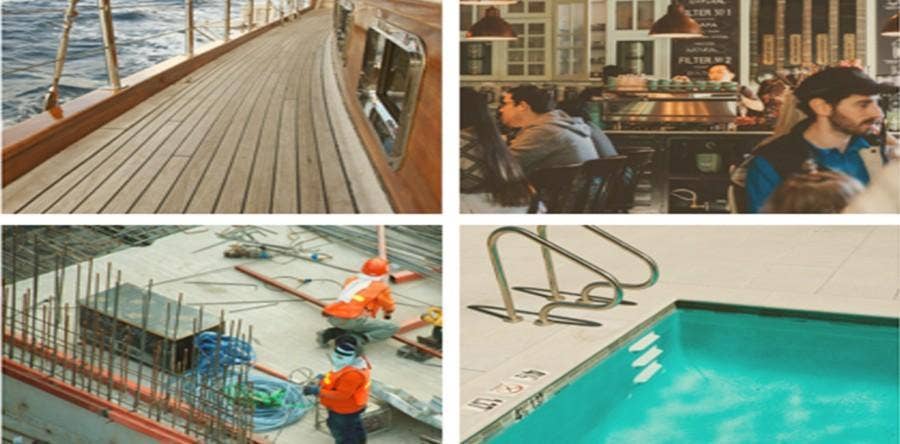Did you know that
slip and falls are the number one cause of accidental injury, resulting in 20.8 percent of all emergency room visits? We are all accident prone, it's a fact of life. With slip and fall accidents bound to happen, all we can do is limit dangers and hazards around areas and learn how to protect ourselves in order to prevent these mishaps from occurring. Some places tend to be more notorious for slip and fall injuries, so we are taking a look at them on the blog today to see what can be done to prevent accidents before they occur and protect people who find themselves in these top places for slip and fall accidents.
BOATS
From small fishing boats to large cruise or naval ships, boating continually ranks as one of the top places to experience a slip and fall accident. Even the safest ships that follow all rules, regulations and technological innovations still have people experiencing slip and fall accidents while aboard. Why? Because when you combine sleek surfaces and the continuous wave motions, accidents are prone to occur. In fact,
wet surfaces make up 55% of all slip, trips, and falls in the hospitality industry! By taking proper precautions, you can greatly decrease the risk that an accident will occur while onboard a boat.
Tips to Prevent Boat Slip and Fall Accidents:

- For indoor areas of the boat, utilize non-slip tape or a non-slip floor coating in the kitchen quarters where all food prep takes place. Jessup’s Flex Track offers a non-abrasive adhesive to prevent slip and falls and is still comfortable on bare feet.
- For exterior parts of boats, consider a stronger grade of non-slip tape or adhesive such as the Safety Track® 3800 Series which can withstand saltwater and ultraviolet exposure.
- Stairs need to have non-slip stair treads applied and handrails in place.
- Specific areas of the boat that need non-slip tape include: ramps, stairs, baths, pools, and the boat deck.
- Make sure proper signage is in place, including wet location exit signs for outdoor areas of the boat.
- Make sure any rugs are secured to the floor to prevent tripping.
- Check lighting in hallways and exterior to make sure areas are well lit.
- Maintain a clean boat. Mop up wet areas and putting proper signage down immediately and remove clutter, cords or other potential tripping hazards.
- Always wear shoes with friction while on a boat.
The
Occupational Health and Safety Administration (OSHA) states that at least 43% of reported maritime injuries are a result of slip and fall accidents. Many boating slip and fall accidents can be preventing by taking the time to implement proper safety measures, offering better training for employees, and improving equipment maintenance.
RESTAURANTS
Because of all the grease, oil, liquid and food in restaurants they are a common offender for slip and fall accidents. Most restaurants take some measures to prevent slip and fall accidents and have floor safety procedures in place, but whether employees are following them appropriately is another question. Here are common best practices when it comes to slip and fall safety prevention at restaurants.

Tips to Prevent Restaurant Slip and Fall Accidents:
- Install slip-resistant flooring. Because the floors of restaurants are being hit with all sorts of liquids, the texture of the floors is extremely important in not only the back kitchen, but the dining and bathroom areas. Choosing a flooring that is slip-resistant will help with the daily hustle, including patrons and employees moving about.
- Install an anti-slip film that is mop friendly to high traffic areas. Using a product like our Safety Track® 3500 Resilient™ Medium Grade anti-slip film around beverage areas, sinks, bathrooms, or in front of the stove can be an extra inexpensive barrier to further prevent slip and fall accidents.
- Consider adding stair treads and ramp tread. Many people are moving around restaurants quickly, so if your establishment has stairs, consider adding stair treads as an added layer of protection.
- Use a NFSI certified floor cleaner to clean your floors. This will ensure they are not slippery, but still perfectly clean.
CONSTRUCTION SITES
OSHA continually puts fall violations within the construction industry as one of their top offenders. In fact, within the construction industry alone 991 workers lost their lives on the job in 2016. Having a fall prevention program in place and implementing a workplace slip and fall training can help give employers and employees the necessary training and tools needed to recognize, assess, and control potential slip, trip, or fall hazards. Consider these tips when working to prevent construction site slip and fall accidents.
Tips to Prevent Construction Site Slip and Fall Accidents:
- Put a clear statement or policy in place regarding the company’s strategy behind your slip and fall program. Help employees understand the purpose of the program and what is expected of the employer and employee, including their responsibilities in slip and fall prevention.
- Training your employees is the greatest way for them to feel confident in their daily duties. A slip and fall training should be part of all employee onboarding and a continual slip and fall education should be held daily, quarterly, or yearly depending on the employees’ position. OSHA found that these types of training can reduce the risk of workplace injury and illness by up to 60%.
- Know your workplace slip and fall risks and continually assess the area for changes.
- Make sure you have the right equipment and products for slip and fall prevention. This will vary depending on your job, but common products used for slip and fall prevention within the construction industry includes:
- Correct footwear
- Handrails on stairs series greater than 3
- Caution signs for level changes
- Grit tape and grit treads in areas with liquid present or where heavy duty resistance is needed
POOLS
Swimming is the fourth most-popular sport in the United States according to the
U.S. Census Bureau. Like any activity involving water, slip and fall accidents are bound to happen. In fact, over
39,500 people annually will seek hospital emergency room care for injuries involving below-ground pools and about 10,000 will need treatment for injuries related to above-ground pools according to the United States Consumer Product and Safety Commission. By limiting the dangers and hazards around pool areas, we can significantly work to prevent pool injuries from slips and falls. You can start by reviewing your pool and applying our tips to help prevent accidents from occurring.
Tips to Prevent Pool Slip and Fall Accidents:
- Start by checking the deck of the pool because it is the most common place for a slip and fall to occur. Often made of concrete, it can create a slip-n-slide effect if not monitored properly. Put proper safety signs in place and work to keep the pool deck dry. This can be easier said than done during busy times, but by making sure to review your horizontal depth markers on the pool deck it can help. They should be slip-resistant to be in accordance with the 2018 International Swimming Pool and Spa Code. Also, make sure the pool deck is slip-resistant at minimum within 4 feet of the pool according to 2018 International Swimming Pool and Spa Code.
- Slide platforms and diving boards should have slip-resistant walking equipment. If steps are being used to access either of these, then the steps should be self-draining, with corrosion resistant stairs and ladders and slip-resistant stair treads.
Steps and ladders should be continually reviewed to make sure they have a slip-proof surface that is working well.
These are just a few places that commonly see slip and fall accidents. The quality of one’s life can be greatly impacted by taking a spill and falling in just the wrong way. By doing your part to work on fall prevention, it can mean the difference between life and death for yourself or someone else. By using our tips and working to put a program in place to plan to protect patrons and employees, you will be doing your part to prevent falls. A slip and fall safety program doesn’t have to be complex, but can make all the difference. By changing some daily habits, making some simple (usually inexpensive) changes, and continually assessing areas you can help to reduce slip and fall accidents. What other places do you commonly see slip and fall accidents occur? What additional tips would you offer up? If you have questions regarding non-slip adhesives, stair treads or other non-slip films contact our team of experts at Jessup Manufacturing to help walk you through the best options to fit your location.




















